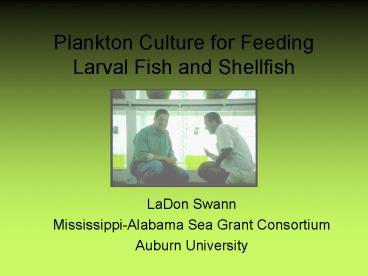Plankton Culture for Feeding Larval Fish and Shellfish - PowerPoint PPT Presentation
1 / 26
Title:
Plankton Culture for Feeding Larval Fish and Shellfish
Description:
Plankton Culture for Feeding Larval Fish and Shellfish. LaDon Swann ... Plankton for Shellfish. Broodstock and Spat. Cell Size 10-24 microns. Species. Tetraselmis sp. ... – PowerPoint PPT presentation
Number of Views:496
Avg rating:3.0/5.0
Title: Plankton Culture for Feeding Larval Fish and Shellfish
1
Plankton Culture for Feeding Larval Fish and
Shellfish
- LaDon Swann
- Mississippi-Alabama Sea Grant Consortium
- Auburn University
2
Shellfish Larval Culture
3
Larval Rearing
- Trocophore
- Size 50-60 microns
- 6-12 hours post-fertilization
- D-Hinge or Straight Hinge
- Size 70-80 microns
- 24-48 hours post-fertilization
- Bivalve Shell
- Velum - Swimming and Feeding organ
4
Larval Rearing
- Veliger or Umbo Larvae
- Size 80-300 microns
- Stage last 8-12 days
- Well defined umbo
- Pediveliger or Eyed Larvae
- Size gt300 microns
- Pigmented eye-spot
- Muscular foot
5
Phytoplankton Production
- Feeding Larvae
- Cell Size 4-8 microns
- Species
- Isochrysis galbana
- Chaetoceros gracilis
- Nannochloris sp.
- Chlorella sp.
- Pavlova lutheri
6
Pavlova lutheri
- Morphology
- Golden brown
- Spherical with 2 flagella
- 3-6 µm
- Salinity
- 8-32 ppt
- Temperature
- 11-26 C
- Culture media
- Guillards f/2
- Proximate Analysis
- 52 Protein
- 24 Carbs
- 29 Fat
7
Isochrysis galbana
- Morphology
- Tahiti (T-Iso strain)
- Golden brown
- Cells spherical with 2 flagella
- 5-6 µm length, 2-4 µm wide
- Salinity
- 8-32 ppt
- Temperature
- 23 - 28C
- Culture media
- Guillards f/2
- Proximate Analysis
- 47 Protein
- 24 Carbs
- 17 Fat
8
Chaetoceros gracilis
- Morphology
- Golden brown diatom
- Medium-size 12 µm wide, 10.5 µm long
- Cells united in chains
- Salinity
- 26 - 32 ppt
- Temperature
- 28 - 30C
- Culture media
- Guillards f/2 with Si
- Proximate Analysis
- 28 Protein
- 23 Carbs
- 9 Fat
9
Plankton for Shellfish
- Broodstock and Spat
- Cell Size 10-24 microns
- Species
- Tetraselmis sp.
- Green
- Thalassiosra sp.
- Diatom
10
Tetraselmis sp.
- Morphology
- Ovoid green cells
- 14 to 23 µm L X 8 µm W
- 4 flagella
- Salinity
- 28-36 ppt
- Temperature
- 22-26C
- Culture media
- Guillards f/2
- Proximate Analysis
- 55 Protein
- 18 Carbs
- 14 Fat
11
Thalassiosra sp.
- Morphology
- Golden brown diatom
- Cells united in chains
- Barrel-shaped
- Non-motile
- 4 µm
- Salinity
- 26 32 ppt
- Temperature
- 22-29 C
- Culture media
- Guillards f/2 with Si
- Other characteristics
12
Micro Algae Culture
- Culture Water
- Sterilization
- Nutrient Enrichment
- Inoculation
- Cell Counts
- Harvest and Feeding
- Stock Culture
13
Culture Water
- Sources
- Seawater
- Saltwater wells
- Prepared seawater
- Salinity
- 26-32 ppt
14
Sterilization
- Methods
- Heat Pasteurization
- 80 C and cool naturally
- Autoclave
- Sodium Hypochlorite (bleach)
- 0.5 ml/L (10 drops)
- Neutralize 10-15 ml sodium thiosulfate (248 g/L)
per liter - Hydrochloric acid (muriatic)
- 0.2 ml/L (4 drops)
- Neutralize Na2CO3 0.4-0.9 g/L
15
Nutrient Enrichment
- Guillards f/2
- Part A and B
- 0.5 ml/L each part
- Na2Si03 for diatoms
Nutrients Conc.(mg/l Seawater)
NaNO3 75
NaH2PO4.H2O 5
Na2SiO3.9H2O 30
Na2C10H14O8N2.H2O (Na2EDTA) 4.36
CoCl2.6H2O 0.01
CuSO4.5H2O 0.01
FeCl3.6H2O 3.15
MnCl2.4H2O 0.18
Na2MoO4.2H2O 0.006
ZnSO4.7H2O 0.022
Thiamin HCl 0.1
Biotin 0.0005
B12 0.0005
16
Inoculation
- Culture vessels
- 1,000 ml flask
- 18.7 L (5 gal.) Carboy (glass)
- 178 L (47 gal) Transparent Tank
- Add enough algae to give a strong tint to the
water - 100,000-200,000/ml
- Lighting
- Types
- Sunlight
- Fluorescent
- VHO fluorescent
- Metal halide
- Highest Densities 24/7
17
Cell Counts
- Peak Algae Density
- I. Galbana
- 10-12 million cells/ml
- 10-14 days
- 2 wk stability
- T. pseudonana
- 4 million cells/ml
- 3 days
- 5 day stability
- Hemacytometer
- Count total in centermost 1 mm
- Multiply by 10,000
- Product number/ml
Motile cells should be killed
18
Harvest and Feeding
- Larvae Density
- 5-10 larvae/ml
- Algae Density
- Wk 1 50,000 cells/ml
- Wk 2 100,000 cells/ml
- Onset of spatting 200,000/ml
- Tank cleared in 24hrs
Liters to feed (TD x V)/CD TD Target
Density (1,000s/ml) V Volume of larval tank
(thousands of L) CD Cell Density
(millions/ml)
19
Harvesting and Feeding
- Batch
- Total harvest occurs once or over several days
- Semi-Continuous
- Works well with diatoms
- Part of the algae remains in the vessel
- New media is added to replenish the algae removed
20
Stock Culture
- Purchase pure strain
- Avoid contamination
- No aeration
- Half filed container
- Redundancy
- Holding
- Test tubes
- Conical flasks
- Transfer
- 1 drop/wk for T. pseudonana
- 1 drop/2 wk for I. galbana
21
Marine Fish Larval Culture
- Relies on zooplankton
22
Marine Rotifer Brachionus plicatilis
- Culture units
- 40L plastic bags
- 40L cone-bottomed tanks
- Temperature 27-30 C
- Salinity 26 ppt
23
Rotifers
- Laboratory production
- 100 to 200 mm size
- 2-3 week life span
- small size suitable as first food
24
Feeding Marine Fish
- Rotifers
- Typical first food in hatchery
- Feed algae or yeast
- Enrichment needed
25
Artemia
- Feeding of older larvae
26
Use of copepods































